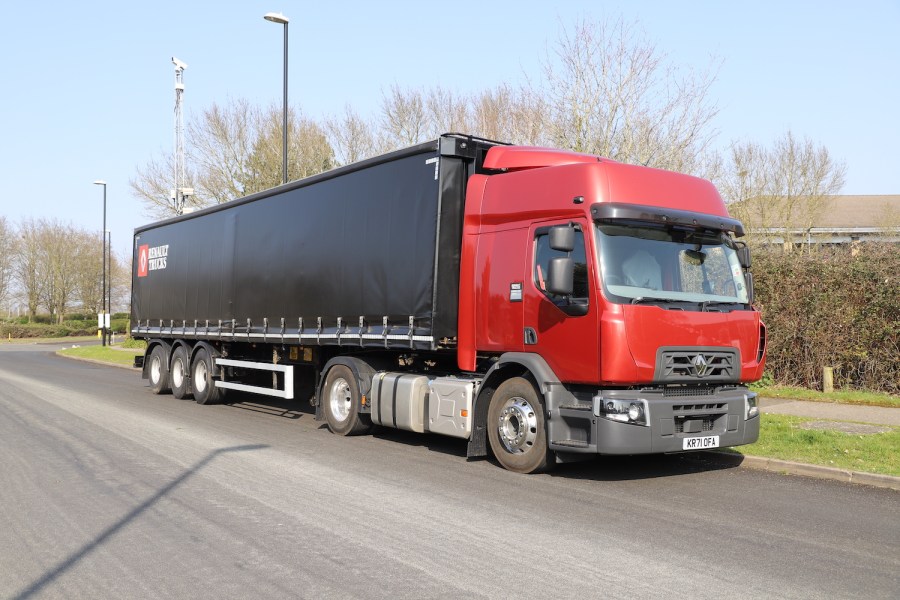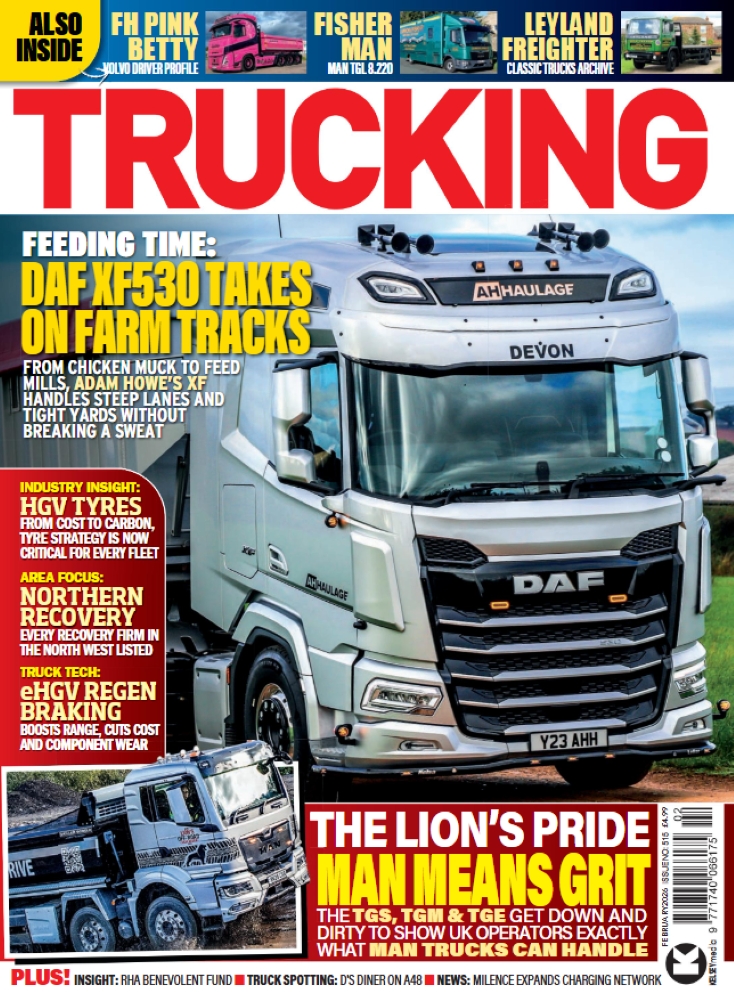Renault’s small-cabbed ‘Wendy house’ Range D430 tractor unit is not a big seller – and while it has some merits, it’s certainly showing its age. But as a truck, is it any good? Let’s put it to the test…
Before we go any further, we admit Renault is rapidly changing our perception about its products – indeed, the Range T High we tested in the July issue was a bit of an eye-opener and a refreshing change. It was a very good truck and above all made a very sound business case.
That was proven to us a few weeks ago when a loyal Scania operator told us he’d taken his first Range T High because it just made economic sense over his Swedish preference. And he was even giving up his beloved manuals to ‘go French’. There is every chance that if his new truck delivers as he hopes, he may not go back to Scania.
The problem is while the Range T High is a true flagship and the Range T is a great all-rounder, at the smaller end of the scale there’s no alternative for Renault other than using the elderly Premium cab as the Range D. And you could be forgiven for not even knowing the Range D tractor unit exists, because Renault has never really plugged the model. It was always assumed if you wanted a Renault for general distribution, a Range T was your best bet.
In fact, the truth is a Range T is indeed your best bet. But Renault does offer a D430 4×2 tractor unit and, more surprisingly, this year it even has one in its press demo fleet. So Trucking asked to take it out – and despite initial bemusement from Renault’s marketing men, they were more than happy to let us take it for a spin.
For those that don’t know, the Range D is the small-cab Renault for general distribution. You’ll typically find the cab on the 4×2 and 6×2 rigids; but as a tractor unit, it’s uncommon.
It is Renault’s alternative to the DAF CF (soon to be XD), Scania P- or G-series, Volvo FM, MAN TGS, Iveco S-WAY AT, and Mercedes-Benz Actros with smallest ClassicSpace cab.
But this cab is actually from the Premium range launched way back in 1996. It appeared in two heights and the lower-height version was reincarnated as the Range D when the Range T appeared nearly a decade ago.
Technical overview
The Range D is mostly used as a rigid, but it is available as a 4×2 tractor for inter-urban distribution. There is no 6×2 option as a tractor unit – not even with a small midlift – so its gross vehicle weight is 40 tonnes, which is the weight our test vehicle was running at.
As you’d expect, the driveline is pure Volvo. The DTi 10.8-litre straight-six engine is rated at 424 bhp between 1700-1900 rpm, with a torque rating of 2050 Nm from 1000-1400 rpm; so the same as an FM11-430. The engine features common-rail high-pressure fuel injection, an overhead camshaft and rear-mounted timing. It meets Euro 6e emissions.
The Optidriver AT 2412F gearbox has 12 forward speeds and an automatic clutch. The front axle is rated at 7500 kg and the rear at 11,500 kg. The wheelbase is 3700 mm. The truck weighed in at 7023 kg, which for a 4×2 with high-roof sleeper is not outstanding, but nor is it appalling.
Inside the cab, the bottom bunk looked comfortable enough, but obviously was not as wide as Range T version as the Range D is that bit narrower. It’d do for the odd night out from time to time, but you wouldn’t want to ‘live’ in this cab for a week – and nor should anyone expect you to.
The truck also has a ‘second bunk’. We say that in inverted commas because it was ‘sort of’ a hammock and not exactly a thing you’d want to sleep on. Because the cab is so small, it can only be fully extended if the seats are tipped forward slightly; and even then, it’s a pain in the backside as it’s on rails and you have to lift it out of a slot, pull it forward and then drop it in another slot to make it flat.
It’s a strange and annoying way to provide a second bunk; and besides, the thought of double-manning in a cab this size with very limited storage really doesn’t bear thinking about.
This top bunk set-up is cumbersome, convoluted and irritating. When it’s in place, you are left with a thin hammock which does not look especially comfortable. It also can’t really be used as a shelf, other than when the truck is stationary. Its rivals in this class – a high-roof small cab such as DAF’s CF Space Cab, Scania’s Highline, or Volvo’s FM Globetrotter are just so much better.
On the road
OK, so the cab is dated, cramped and mildly impractical; but how good is it on the road? Well, here the little Renault starts to clawback some credibility.
One thing that instantly struck us was its pulling power, which is very impressive. With 424 bhp on tap at 40 tonnes, it works out to just over the ‘benchmark’ 10 bhp per tonne – not a bad power-to-weight ratio at all. It accelerated exceptionally well, which is a major plus point; especially if time is of the essence in your work.
The D430 also handled very well indeed. Inside the cab was a little bit noisy for our liking – maybe because of its age – which would become off-putting during a long shift. But in terms of performance, we genuinely couldn’t fault it. We’ve driven many trucks in this power category and they have been sluggish, but this little Renault is actually very nippy indeed.
We took the D430 on a circular trip from Warwick, through Kenilworth and Balsall Common, up to the M6 and then for a short blast along the motorway before returning via Coventry, Leamington and back to Warwick. That gave us a chance to undertake some town driving, A-roads, B-roads, dual-carriageways, motorways and also experience some stop-start roadworks as well.
In fairness, the truck performed better than we’d expected. For a distribution truck, it wasn’t too bad a drive at all. Not enthralling, not amazing; just competent. By today’s standards, the truck is relatively basic and spartan inside.
It has little ‘wow’ factor; it’s functional, but quite dated – especially the dash. There are annoying features, like the cruise controls split into two sets of buttons either side of the steering wheel.
Verdict
This truck does the job, but it won’t get your excitement levels up. It’s a distribution truck, so perhaps it’s not meant to excite. However, it’s incredibly hard to make a solid case for buying this truck over its rivals.
Why? Well, the main thing is Renault’s list price for it is the same as a Range T! So unless you get a good discount on it, it’s hard to persuade any operator or take a Range D over a Range T. The D’s only plus point is it will be lighter than a T, and lighter still with a flat-roof sleeper or a day cab. It’s not available as a 6×2, and the market for 4x2s is still fairly limited.
It’s simply impossible to prefer the Range D compared with a DAF CF, Volvo FM, Scania P-series and indeed every other small-cabbed tractor on offer.
Sadly, with its 26-year-old cab, the D430 is very dated. You can argue the CF cab is older – it is – but its refreshes have been far superior, and more regular. If DAF’s XD follows on from the new XG, then it may well move to the top of the tree of the ‘Wendy houses’.
The Range D might be cheaper than those rivals – certainly than the Swedish models – but any gains may be lost when it’s time to sell it on.
Supermarket Iceland – which used to have basic Premium models with flat roofs, but the higher cab – has put a lot of Range T day-cab 4×2 tractors into its fleet, which further highlights the market for the D430 is pretty limited.
As a truck, it’s fine. If you operate an all-Renault fleet and need a tractor that’s lighter than a Range T, there’s a crumb of a case for it. But as an investment, it starts to wane in appeal. Most operators in the market for a 400-450 bhp, small-cab 4×2 would probably be better looking elsewhere; and the fact this is such a rare truck suggests they already do.
In fairness, we don’t think Renault is pinning its long-term prospects on the Range D as a tractor unit; and given the Range D is a rigid as well, maybe a new cab will be on the horizon. If that were to be the case, we hope it has a better upper bunk!
That said, next year there might be a couple of ex-demo D430 4×2 tractors available at a bargain price…
We like
- Pulls well
- Easy entry
- Volvo driveline
- Nippy
- Handles well
We don’t like
- Dated cab
- Pricey for what it is
- Pointless top bunk
Test Specification
Model: Renault Range D430
Design GCW: 40,000 kg
Chassis: 3700 mm wheelbase
Front axle: 7500 kg capacity
Rear axle: 11,500 kg, 2.47:1 ratio
Gearbox: Optidrver AT2412F automated 12-speed
Engine: DTi-11, 10.8-litre, straight-six, SCR
Max power: 424 bhp @ 1700-1900 rpm
Max torque: 2050 Nm @ 1000-1400 rpm
Cab: D high-roof sleeper






